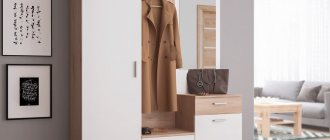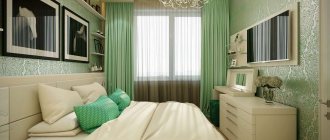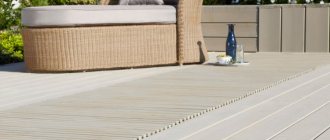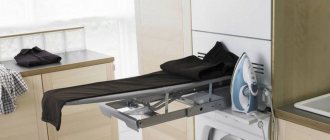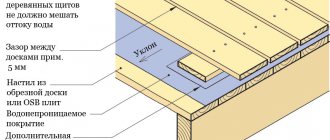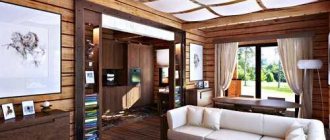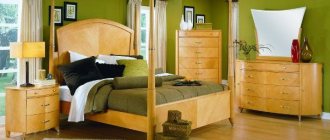In the closet
Does the room fit a large wardrobe or even a dressing room? The question of storing the board disappears by itself. You can hide the device when folded in a pre-selected compartment, an empty part of a corner cabinet, or hang it on the side wall of the frame. If you are just planning to buy a cabinet, you can order a special internal filling with a built-in ironing board.
How to hide a board in furniture?
Most homes have closets or chests of drawers that can accommodate an ironing board. This solution is suitable for small boards that will fit in a drawer.
Related article: Original hangers for the hallway
To apply this solution, it is important to choose the correct location of the chest of drawers or cabinet, so that the board pulled out of the drawer does not interfere with the passage or opening of doors and it would be comfortable to iron things on it.
Some manufacturers of modern furniture took care of people experiencing this problem and immediately installed the board in a special drawer of a dresser or cabinet.
Many modern cabinets are equipped with vertical drawers, which are perfect for placing a board. You can install the board on hooks or hangers inside the box. For a more secure fastening, you can stretch the elastic band, securing it on both sides. The elastic band can be pulled out easily, so it won’t interfere much with getting the board out.
You can hide the board in a kitchen drawer. This solution will be useful for owners of studio apartments.
Behind the mirror
Such designs reliably disguise the ironing device and do not spoil the appearance of the room. The main advantage of a board built into a mirror is convenience. It easily unfolds and hides after use. You can order a ready-made piece of furniture or make it yourself.
In a wall cabinet
You can also make a small hanging cabinet yourself. Its difference from the previous version is that not only a board, but also an iron and ironing supplies fit inside the structure. The cabinet is slightly wider than the mirror, but fits perfectly into the decor and serves as additional storage space.
Which room to choose for ironing
If earlier the folding table was not given due attention, today people think about its location in advance.
Option No. 1 - insulated loggia
If the loggia is spacious and insulated, you can install an ironing system along with a dryer and a dressing room.
Option No. 2 - spacious bathroom
Suitable if the bathroom is spacious and its tiled or porcelain tile floor is heated. But even in this room, the board when unfolded will get in the way. Therefore, designers recommend paying attention to retractable models; their size is usually small.
Option No. 3 - kitchen
Often kitchen furniture has a section for building in an ironing table. If your choice fell on just such a set, then choose the option in which the retractable ironing board is laid out not across the kitchen, but along the countertop.
In the chest of drawers
And this is a real find for connoisseurs of versatility. A chest of drawers with a built-in ironing board is considered a convenient, and even an indispensable piece of furniture for some housewives. You can store things and an iron inside it. Today, manufacturers produce transforming chests of drawers that will fit into any interior style.
On the door
Special devices will allow you to make the most of the space in a small apartment. There are both special ironing boards for door leaves and separate fastenings. The only problem is the inability to enter and exit through the door while ironing.
On the balcony
The insulated loggia and balcony can be used as a utility room for drying and ironing clothes. The ironing board can be built into a closet, if you have one, or you can purchase a special design that is attached directly to the wall. On a fairly wide balcony, designers suggest placing the device not lengthwise, but across it: this way it will be more convenient for the hostess or owner to iron the laundry.
History of ironing boards, ironing tables, ironing boards
Ironing tables, ironing boards, ironing blankets
It may seem obvious that ironing should be done on a flat surface, but there were exceptions.
The Chinese pan iron sometimes used a cloth stretched in the air between two people. The ancestors of the ironing board in the West include whalebone ironing boards. buried with Viking ladies, and in the East, stone slabs were used for ironing Korean clothes. sticks. (See "History of Ironing" page.) Ironing boards are thought to be about 33cm or 1ft long. Used with glass ironing towels, also found in Viking burials. Boards small enough to be held on laps were still in use in the 19th century . Known as press boards, they were often used for pressing seams in dressmaking, but could also be used in ironing linen.
A kitchen table or board supported by two chairs was commonly used for ironing.
even before the advent of the mass-market folding ironing board. (See the picture to the left of a woman holding an iron on a board balanced over chairs). in business books of the 19th century about what size an ironing board should be (different opinions), what wood it should be made of (soft light wood for cleanliness, oak for strength) and how it should be covered (an ironing wool blanket of white flannel or red flannel with a sheet or ironing cloth on top).
Swanskin was often recommended in England as an ironing blanket. Nothing to do with large feathered wings, and the ironing boards were covered with thick scarlet cloth. Using red wool Cloak for this purpose was frowned upon by 19th century English women writers, but it must have been quite common, otherwise it would not have been mentioned so often.
(See Quotes below) At George Washington's home at Mount Vernon in Virginia, ironing blankets were made from thick woolen "strakhnot" fabric.
Folding ironing boards arrived as Victorians turned their ingenuity to finding better ways to manage their households. The first US patents on them appeared in the 1860s. Some shapes we would now call ironing boards are ironing boards. Inventors developed ironing bureaus and even ironing tables in combination with stitches. Various boards were made for special tasks, such as ironing sleeves, and board accessories for special jobs, such as ironing bonnets. While the woman (above right) in North Dakota in 1940 has a drop board, she does not use an electric iron, but a sadiron with a removable handle is probably the famous Mrs.
Potts Patented Iron. Note the heating of the two spare iron bases on the stove.
This 1866 U.S. patent (left) describes "A new and improved ironing board, adapted principally for use in women's dresses and other skirts, bibs, or any article of clothing requiring ironing, single, and with a hood attached to the neck of the ironing board, caps and other items of clothing can be ironed with great advantage. The essence of my invention is to improve the ordinary ironing board, in comparison with which it has many advantages. It is lighter and stronger, and when expanded, it can be placed anywhere and when not in use, can be folded down to the size of a regular board, making it very convenient.
»
Don't even think about using a red cape on your ironing board!
No one but a complete rag would use her red cloak as an ironing blanket.
Esther Copley,
Comfort Cottage
(1825)... her best red cloak, which she always wore for ironing on Sundays, for her cloak when she traveled, and for her blanket at night; Rachel was such a pathetic manager!
Hannah More,
Black Giles the Poacher
(1796)... a white table at which [the old woman] was ironing; her red cloak is an ironing pad; her hand still held the iron, she moved slowly...
Maria Louisa Charlesworth,
The Cottage and its Visitor
(1856)
irons and ironers >>>> frill irons
. ...press board on her knee, where she clutches next year's Sunday vest to Zephaniah Pennela. How she makes her heavy tailor squeak at work...
Harriet Beecher Stowe,
The Jewel of Orr's Island
(1862)
